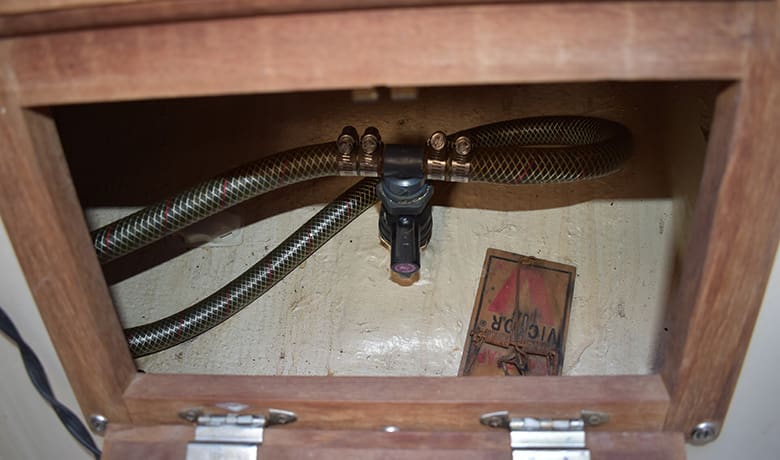
My first experience with rats onboard happened years ago when I borrowed a friend’s Catalina 28 for a long-range cruise. The first night out my girlfriend heard strange clicking noises coming from the bilge and was convinced we had a rat problem. I set a trap and spent hours searching every nook and cranny — I found nothing but a rusty screwdriver and a can of beans. I told my problem to an old salt I knew and he laughed, “those were mating shrimp you were hearing, Rookie!” Though somewhat embarrassed, I was still happy there were no rats on board.
Mariners around the globe know that the only way to absolutely avoid having pests on board is to not own a boat. They also know (to the chagrin of first mates everywhere), that because boats offer food, water, and shelter, pests will come aboard on even the cleanest, most well-maintained vessels. There’s nothing to do but prepare to deal with them when it happens.
Aside from man, the rat is by far the most voracious creature on earth. Each year they consume one-fifth of the world’s agricultural products and cost the U.S. more than $500 million in economic losses. They are truly opportunistic omnivores, devouring almost anything they can get their little noses into — up to 40% of their body weight every day. And what they don’t eat they chew: wood, PVC, plastic, paper and electric cable are but a few of the things rats like to use for bubble gum.
Hard to believe, but the ubiquitous rat is not indigenous to North America. We have European settlers to thank for the introduction of the Norway rat in the sixteenth century, when the little stowaways boarded their ships the same way they got on mine: via dock lines. Captain John Smith complained of rats cleaning out their grain stores in Jamestown, and they quickly infested all 13 colonies and moved westward with the settlers. Since then they have had their own version of manifest destiny, sweeping the continent with the exception of Alberta, Canada, which has had a successful eradication program since the 1950s.
Oh, rats
Being a boat owner for many years, I guess it wasn’t a matter of if we would get a visit from these commensal varmints, but when. Our “when” happened recently when I went aboard for a final prep before a weekend outing and discovered dozens of small rice-like feces on almost every horizontal surface, and almost every piece of paper shredded. What a mess! And then I saw what amounted to the final straw: the rat had chewed through a plastic bottle that held a fifth of Mount Gay rum. I gnashed my molars and ruminated out loud: “I hope you enjoyed that cocktail my little drunken friend, it will be your last.” It was now a battle to the death twixt me and Mr. Rat.
I abruptly canceled the trip with a fabricated excuse. I mean, can you imagine my family’s reaction to seeing a rat on board at a secluded anchorage? Not a pretty picture. The local hardware store had rodent control products, but no one there could make a recommendation based on actual experience. I tried the humane route first: I placed a couple of glue traps on the sole, but it yielded only grey fur a day later. Great, now I had an angry rat on board. I delayed our outing again and went beating a path for a better mouse trap.
As I searched for a way to eliminate our uninvited guest, I came across the following troubling info in Robert Hendrickson’s book, A Social History of Rats & Men:
• It’s estimated that there is one rat for every person in North America
•Rats can swim a half-mile against the current in open water (is your boat on a mooring?)
• They can jump four feet horizontally and two feet vertically
• They can get through a hole as small as a quarter
There is perhaps no more apt metaphor than to say that something, “breeds like rats.” The females are almost constantly in heat and will, provided there is sufficient food and shelter, produce 30 or more offspring per year.
I bought a snap trap, and just for kicks I tripped it with a pencil to see how well it would work. It snapped it cleanly in two, good. I then set it with peanut butter (much preferred over cheese) and placed it on the sole by the galley. A day later the trap was still set, the trigger mechanism licked clean. I reset it and let another day pass. When I pulled the companionway boards on the third day I discovered the largest rodent I had ever seen outside of the movie “Willard.” From seven feet above I could tell the color of its eyes (black like a shark) and count its toes.
I bagged it and before locking up I thought, just in case, to reset the trap. A few days later I came on board to prepare again for a sail outing and… whoa, another dispatched rat.
Upon removing Mrs. Rat I felt that it was time to get the marina owners involved. After all, those rats had to pass about 75 boats to get to mine, there was a good chance that other boaters were having problems too. The nature of this information can instinctively put someone on the defensive, so when I phoned the manager I tried to be as delicate as possible. She gasped at the news and claimed that in 70 years I was the first slip holder to ever complain of a rat. I paused, and refrained from saying that I didn’t buy that for one minute, and I let the matter drop.
Since then I have been careful to seal up the dorades before locking the companionway and we have, thankfully, remained rodent-free. But just in case, I keep my rum in a glass bottle.
Robert Beringer is a marine journalist/photographer, author of Water Power! For free sample go to: http://www.smashwords.com/books/view/542578.

